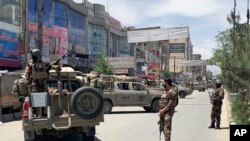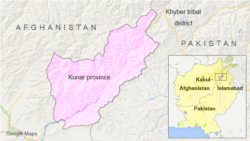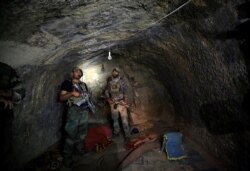As mourners gathered for the funeral of an influential police commander in Afghanistan’s eastern Nangarhar province, a suicide bomber detonated his explosive vest, killing at least 20 people.
Hours later, IS-Khorasan, Islamic State’s Afghan affiliate, posted a communique online, claiming Tuesday’s attack as its own.
A day earlier, the group claimed responsibility for back-to-back blasts that targeted a security convoy in Kabul, saying the target was a high-ranking Afghan intelligence official.
While officials have yet to confirm IS-Khorasan’s involvement in either of the attacks, some say such claims should serve as a warning that the group’s ability to survive adversity should not be underestimated.
“It would be premature to say that the organization as a whole has been neutralized or defeated,” an international counterterrorism official told VOA prior to Tuesday’s bombing.
“The history of ISIL-Khorasan up to now is that they have been reasonably resilient,” he added, speaking on the condition of anonymity due to the sensitive nature of the intelligence.
That counterterrorism officials are even willing to think along those lines, according to some analysts, is a testament to the group’s tenacity in the face of multiple setbacks.
The most recent blow against IS-Khorasan came earlier this week, when Afghanistan’s National Directorate of Security (NDS) announced the capture of three senior officials, including the group’s leader, Zia-ul-Haq, also known as Abu Omar Khorasani.
And a series of raids in Afghanistan’s capital, Kabul, last month netted another key IS-Khorasan leader, Abdullah Orakzai, and 19 associates.
The arrests follow months of setbacks for the terror group, including defeats in Afghanistan’s eastern Nangarhar province last November and in Kunar province in March, which U.S. defense officials described as significant.
The international counterterror official said IS-Khorasan’s loss in Nangarhar province, in particular, was a “body blow” that cut its fighting force in half, to about 2,500 fighters.
The survivors and their families were forced to beat a retreat to the mountains of neighboring Kunar province, where conditions were not kind.
“Kunar is just so difficult. The terrain there is so tough. The altitudes are high,” the official said. “It’s very, very hard just to survive.”
By mid-March, survival for IS-Khorasan in the region had become nearly impossible.
“The entire province of Kunar was cleared of Daesh criminals,” Taliban officials announced, using the terror group’s Arabic acronym.
Some intelligence estimates suggested the terror group’s fighting force had again been halved to about 1,000 fighters.
One U.S. intelligence assessment, released earlier this month, said what was left of IS-Khorasan has been "reduced to pockets in western Kunar province."
But like their international counterparts, U.S. military officials are wary.
“ISIS-K continues to launch attacks in Afghanistan and remains a security concern,” Army Lt. Col. Thomas Campbell, a Pentagon spokesman, told VOA, using another of the terror group’s acronyms.
He added that both the U.S. and Afghan security forces “continue to actively combat ISIS-K through counterterrorism operations.”
One reason to be cautious is that IS-Khorasan had been in what, at the time, seemed to be an even more dire predicament, only to bounce back.
In April 2017, the U.S. dropped the largest non-nuclear bomb in its arsenal, a GBU-43 Massive Ordnance Air Blast, on a key IS cave and tunnel system in Nangarhar province.
Over the next several months, a series of subsequent strikes killed the then-IS-Khorasan emir and his replacement and cut the estimated number of fighters from 3,000 to 600.
Only two years later, IS-Khorasan’s number had grown almost eightfold.
This time, IS-Khorasan may not have the luxury of established havens, but it continues to find a way to hold on.
“ISIS-K does still have an operational network in Kabul and a presence in eastern Afghanistan,” according to Thomas Joscelyn, a senior fellow at the Foundation for Defense of Democracies.
“It just isn’t clear how big they are at this point. That is, how much overall capacity ISIS-K has left,” he said.
In a country still wracked by fighting and instability, and home to an estimated 8,000 to 10,000 foreign fighters, intelligence and counterterror officials warn it is not impossible for IS-Khorasan to revive itself and regain its footing.











